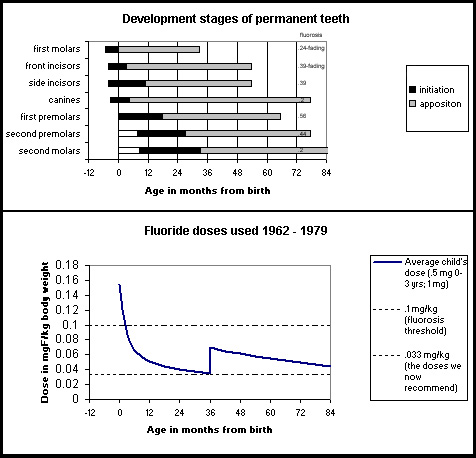|

Development stages of teeth versus fluorosis
The general idea here is to look at what the teeth
are doing (top graph) as the fluoride is taken (bottom graph). Then look at how severe the fluorosis is (the little numbers
added to along the right side of the top graph).
Let's use the top tooth as an example. At birth (zero on the age
scale) the first molar is starting the stage called apposition (the lighter part of the bar). And way off to the right you
can see the fluorosis score, ".24 fading". The higher this score, the more fluorosis there was on that tooth type.
Note that the bottom graph is lined up, time wise, with the top graph.
Now, scanning all the effects on all the
tooth types, I can draw a generality. What it says to me is that the most sensitive stage of tooth development is probably
the "initiation" stage. Here is how I come up with this.
If the high doses at birth hit near the end of
the initiation stage, as in the first molars, the fluorosis is very mild and tends to fade. If the high doses hit right at
the beginning of initiation, as in the first premolars, the fluorosis is at its most severe. If the high doses hit well before
initiation, and then are lower when initiation starts, as in the second molars, the fluorosis is also very mild. (The canines
with their mild fluorosis are the only teeth that do not fit the pattern.)
Here is a brief summary of the stages of tooth growth. The initiation stage is the beginning of the growth of a tooth.
For our purposes we can think of initiation as beginning a cellular stage of growth, when cells form the outline of the eventual
shape of the tooth.
The next stage of growth is apposition. This is the "matrix" stage, when the cells
above start secreting matrix, which is sort of like cartilage. The matrix makes a complete tooth. In the next stage, calcification
(not shown on the graph), the matrix tooth is mostly dissolved and replaced by calcium and phosphorus, which makes the tooth
more bone like.
It does appear that the time near birth, when the main "smile teeth" are in the critical
initiation stage, is the main time to be concerned with fluoride overdoses.
Physical effects of fluoride
|



